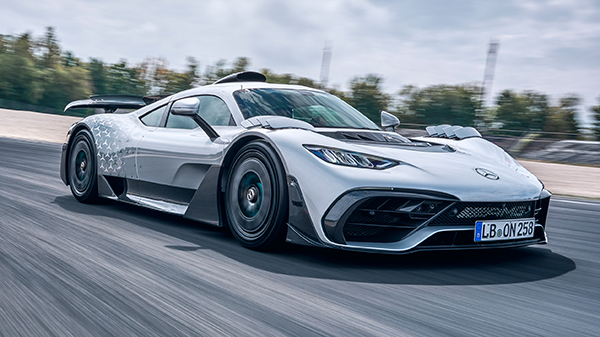After the introduction of the 4-cylinder and V8 versions, Mercedes presents the top version of the Mercedes-AMG GT. The new Mercedes-AMG GT 63 S E Performance is equipped with the P3 PHEV system from the AMG SL 63 S E Performance and AMG S 63 S E Performance and develops 816 PS and 1,080-1,420 Nm, accelerating from 0 to 100 kph in just 2.8 seconds, 0.1 seconds faster than the Mercedes-AMG One.

In the autumn of 2014, Mercedes-AMG presented the Mercedes-AMG GT, the successor to the SLS AMG, at the Paris Motor Show, but at a much lower price. Available for sale from spring 2015, the Mercedes-AMG GT sold for six and a half years until the end of 2021. Then, the AMG division decided its successor needed a dedicated platform and developed a new architecture called MSA (Modular Sports Architecture) for the new SL and the new AMG GT, which was unveiled at the end of 2023. Thus, the new AMG GT now offers a 2+2 seating configuration, just like the AMG-SL. Like the AMG SL, the new Mercedes-AMG GT debuted with 4-liter V8 engines (AMG GT 55 4Matic+ and 63 4Matic+), followed by the 4-cylinder version (AMG GT 43), and now the top model with the P3 PHEV system from the AMG SL 63 S E Performance has been launched.
It combines the 612 PS and 850 Nm front-mounted 4-litre twin-turbo V8 engine with a 150 kW/204 PS (70 kW continuous power) rear axle-mounted electric motor. The permanently excited electric motor at the rear is coupled with an electrically switched two-speed transmission and a mechanical rear-axle limited-slip differential. The PHEV system’s 6.1 kWh Li-Ion battery is located above the rear axle and provides an electric range of 13 km. The electric motor drives the rear axle directly, but if the ESP system detects rear axle slip, part of the electric motor’s power is transferred to the front via the PTO shaft. The PHEV system develops 816 PS and between 1,080 and 1,420 Nm in total.
The car comes standard with all-wheel steering and AMG Active Ride Control semi-active suspension. The dampers, which have two control valves, one for the rebound phase and one for the compression phase, have interconnected semi-active hydraulic elements that have replaced conventional torsion bars and reduce body roll.
Like the AMG SL 63 S E Peformance, the Mercedes-AMG GT 63 S E Peformance has an active aerodynamic element hidden in the floor in front of the combustion engine. This carbon profile automatically expands by 40 mm at a speed of 80 kph and creates a Venturi effect that virtually glues the car to the road and reduces lift forces at the front axle. The active spoiler also has five different positions from 80 kph, depending on the chosen driving program.
The driver can choose between eight driving programs: “Electric’” “Battery Hold”, “Comfort”, “Slippery”, “Sport”, “Sport+’, “Race”, and “Individual”. These can be accessed using the AMG button and the central display in the center console or via the AMG steering wheel buttons. The driver can also opt for four degrees of energy recovery using the right AMG steering wheel button.

Styling differences from the rest of the range
The Mercedes-AMG GT 63 S E Performance comes with several elements that differentiate it from the rest of the range: Carbon ceramic disc brakes with bronze painted calipers, 6-piston front (420 x 40 mm, front discs), and 1-piston rear (380 x 32 mm, rear discs) calipers, flap with load port located on the right rear under the taillight and GT 63 lettering, twin trapezoidal tailpipe and standard 20-inch wheels (295/35 R20 front and 305/35 R20 rear tires), with optional 21-inch forged wheels available.
Surprisingly, the Mercedes-AMG GT 63 S E Performance accelerates from 0 to 100 kph in just 2.8 seconds, 0.1 seconds faster than the Mercedes-AMG One hypercar, while the top speed is 317 kph compared to 352 kph in the AMG One.
Mercedes-AMG doesn’t reveal the kerb weight of the AMG GT 63 S E Performance, but the AMG GT 63 4Matic+ version equipped with the twin-turbo V8 engine weighs 1,970 kg while the Mercedes-AMG One is 1,770 kg. The PHEV version of the Mercedes-AMG GT 63 S E Performance weighs in at around 2,100 kg for sure, over 300 kg more than the AMG One. Although it has only 816 PS compared to 1,063 PS in the AMG One, the AMG GT 63 S E Performance accelerates faster from 0 to 100 kph, probably thanks to the all-wheel drive traction that can transmit its immense power to the ground more efficiently.
Mercedes-AMG GT 63 S E Performance Is 0.1 SEC Faster Than Mercedes-AMG One
23/04/2024
No Comments
Mercedes-Benz | Mercedes-AMG
Click to rate this post
[Total: 1 Average: 5]